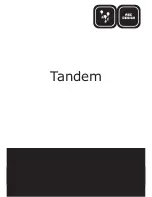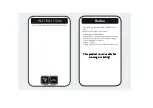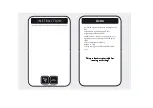
Installation and Operation Manual
Blue Sky Energy | USA |
www.blueskyenergyinc.com
12
BATTERY & PV POWER CONNECT / DISCONNECT ORDER
➢
CAUTION:
When applying power to the 3000i, battery power should be connected first followed by PV power.
Disconnect PV power first when removing power. DO NOT disconnect the battery while the 3000i is in a Charge ON state
with PV power connected. A healthy battery is a key component of the charge voltage control system and provides a very
important charge voltage filtering function. Removal of the battery while the 3000i is charging may produce voltage spikes
at the
3000i’s
battery terminals which may damage 12V appliances still connected to the output 3000i.
IF THE BATTERY MUST BE DISCONNECTED, REMOVE PV POWER FIRST.
Connecting the Battery
Before attaching battery wires to the 3000i confirm proper voltage and polarity. With battery power attached the 3000i should boot and self-test. All
displ
ay segments and LED’s will
briefly illuminate during self-test, followed by a brief display of the software revision. Following self-test battery voltage
will be displayed although the display will be dim due to the night time dimming function. If the display does not turn on check voltage on the
3000i’s
battery terminals. Voltage should be the same as present on the batteries, of the proper polarity, and greater than 9 volts for the 3000i to operate.
Connecting PV Modules
Before attaching PV wires to the 3000i confirm proper voltage and polarity. Measure PV module voltage with PV modules in the sun and disconnected
from the 3000i. Confirm open circuit voltage is within the range of
18
–
35 volts and of the proper polarity. If PV open circuit voltage is outside this
range confirm proper PV module selection and wiring. Attaching PV power should cause the 3000i to switch to Charge ON state.
➢
CAUTION:
PV voltage exceeding 50 volts will damage the 3000i and void the limited warranty. The 3000i is
protected against limited duration reverse PV polarity. If available PV current is high and reverse PV polarity duration
is long, damage may result which voids the limited warranty. Immediately following PV power connection confirm
that the 3000i display continues to operate normally and the unit switches to a Charge On state as expected.
Reverse
PV connection will cause the display to continuously show the self-test indication of all display segments and
LED’s
on, and the front panel may get hot quickly. Should this occur immediately remove PV power and correct the fault.
INSTALLING A MULTI-CONTROLLER SYSTEM USING THE IPN NETWORK
The 3000i may also serve as an IPN Network Master controlling up to 7 remote IPN Network compatible Slaves. Any Blue Sky Energy charge controller
capable of operating as an IPN Network Slave may be used, and as of this writing include; SB3024i SB3024Di, SB3024iL SB3024DiL, SB2512iX, SB2512iX-
HV, and SB1524iX. Another 3000i cannot be used. Controller types and their PV modules may be different. Each controller is installed as a separate
standalone charging source connected to the battery and are then networked together. The 3000i serves as the charge control and network
communication Master, controls the charging process, and directs the activities of one or more Slaves. No additional communication hardware or
software is required to setup or operate the network. A network communication link is established between controllers by daisy chaining a twisted
pair cable from the IPN Network terminal block, controller to controller (A-to-A, B-to-B) as shown in Figure 6. Up to 8 IPN based charge controllers can
be connected together in a multi-controller system. The 3000i is fixed as device address 0 (zero) and serves as the IPN Network Master. Attached
controllers are configured as Slaves set to addresses 1 through 7. If an optional battery temperature sensor is used, only one is required and it must
be connected to the 3000i (Master) to be recognized and shared. Optional displays or UCM may connect to any controller on the network.
MULTI-CONTROLLER WIRING AND SETUP
➢
CAUTION:
A multi-controller system requires the following specialized installation and setup:
1) Each controller must be a separately installed charging system and connect to and charge the same battery.
2) Attached Slave controllers must be set to addresses 1
–
7 with no two controllers set the same. (3000i is fixed to
IPN address 0 and is the charge control Master.)
3) Charge parameters are set in the Master only.
4) While outputs connect in parallel to a common battery, PV inputs must be completely separate. A large PV array
must be divided into sub-arrays, each with separate PV+ and PV
–
wiring to their controller.
5) All controllers must be connected to the IPN network as shown in Figure 6.
IPN NETWORK WIRING
FIGURE 6
Title :
From Au toCAD Drawing "f :\RVpo we r\ au toca d\library\W AR-CAUT"
Cre at or:
Aut oCAD
Previe w:
Th is EPS pictu re was no t save d
with a p re vie w includ ed in it.
Commen t:
Th is EPS pictu re will prin t t o a
Po stScript printe r, bu t n ot t o
ot he r t ype s of printe rs.


































